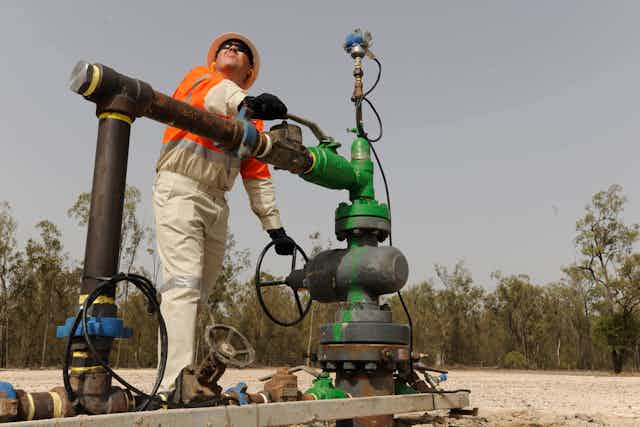Water produced when coal seam gas (CSG) is extracted from below ground can be safely re-injected hundreds of metres underground, according to new CSIRO research.
Water is pumped out of coal seams to access the gas held within them. CSG in the Surat Basin, Australia, produces on average 70 gigalitres of water each year - a seventh of the water held in Sydney Harbour. What to do with this water is one of a number of concerns voiced by communities around CSG.
Our research shows that injecting large volumes of treated CSG-produced water at suitable locations within the Surat Basin is unlikely to cause any harm to groundwater quality.
However, to achieve this the water has to be treated adequately to eliminate the risk of polluting groundwater with arsenic – a generally immobile toxic element that occurs naturally in some of the rock formations being considered for re-injection.
Why re-inject CSG water anyway?

In Queensland, the state government’s policy on managing “produced water”, also commonly known as “CSG water”, is to “encourage the beneficial use of CSG water in a way that protects the environment and maximises its productive use as a valuable resource”.
In many cases the most suitable and socially accepted option is to treat the water using reverse osmosis technology and then inject it into deep aquifers. The re-injected water can be used to top up already stressed aquifers.
However, looking at similar projects around the world, especially from Florida, has shown that injecting clean water underground can sometimes mobilise naturally occurring contaminants such as arsenic.
When rainwater seeps underground and becomes groundwater it changes its composition. During the subsurface passage that can often take thousands of years the groundwater composition changes slowly to successively take on the characteristics of the rocks.
When water with a non-compatible composition is directly injected into deep aquifers, the injected water will also react with the rocks and therefore change its characteristics to one that is compatible with the new host rock. This occurs through the release of elements from the rocks, a process called mineral dissolution.
In addition, arsenic mobilisation can also occur by a process called desorption, in which case loosely attached ions are released from mineral surfaces. Both processes may proceed until a new balance or “geochemical equilibrium” is established and both have the potential to mobilise toxic elements such as arsenic.
Testing the waters
In our new research, we analysed results from injection experiments at Reedy Creek and at Condabri, both located in the Surat Basin in Queensland, through computer models that simulate groundwater flow and quality.
This analysis showed that whether and how much arsenic is mobilised depends on the composition of the injected water. We conclude that minimising arsenic release most importantly depends on oxygen being stripped from the water before it is injected.
During the research elevated arsenic levels have been found during a field experiment at one of the sites (Reedy Creek), for which both experiments and computer modelling suggest that arsenic release was triggered by the injected water.
However, computer modelling also demonstrated that this type of arsenic mobilisation could have been completely prevented by adjusting the pH of the injected water to that of the naturally residing groundwater.
The experiments performed at the second research site at Condabri under different experimental conditions showed that arsenic concentrations in the groundwater increased substantially if the injected water was not stripped of oxygen.
When oxygen was not removed from the injected water this caused the dissolution of the naturally abundant mineral pyrite, or “fool’s gold”. Arsenic is often embedded in trace amounts in this mineral.
What can we do?
The findings from this research were used to guide the design requirements for the large-scale implementation of CSG water injection into the Precipice aquifer. During the treatment process all water is now de-oxygenated before injection and the pH of the injected water is similar to the natural groundwater.
The Reedy Creek re-injection scheme is now successfully operating and injecting treated CSG water. Since starting the injection in 2015, more than 10 gigalitres has been injected into the Precipice aquifer and the scheme is currently Australia’s largest treated water re-injection scheme.
As a result, groundwater levels in parts of the Precipice aquifer have started to rise for the first time in the past few decades.
This article was updated on December 2 2016 to provide further detail on GISERA in the disclosure statement.

